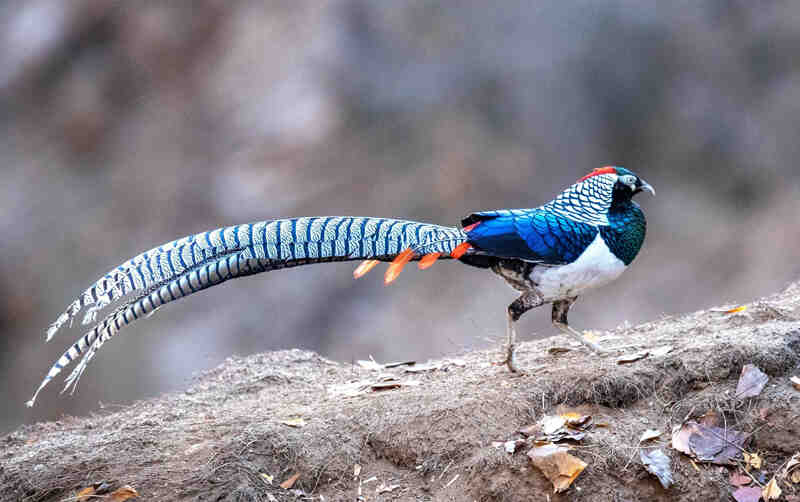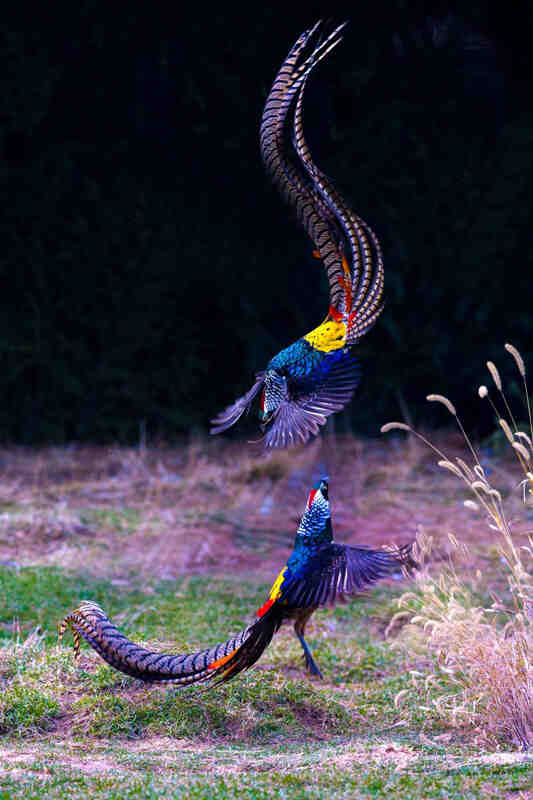Chrvsolophus amherstiae
IUCN
LCBasic Information
Scientific classification
- name:Chrvsolophus amherstiae
- Scientific Name:Chrvsolophus amherstiae,Lady Amherst's Pheasant,Bronze chicken, bamboo chicken, quilt chicken, turnip chicken, silver chicken
- Outline:Landfowl
- Family:Gallinomorpha P.family Caragana
Vital signs
- length:54-145cm
- Weight:585-960g
- lifetime:12-15years
Feature
In traditional Chinese culture, it is a symbol of wealth and good fortune and one of the most beautiful viewing pheasants in the world
Distribution and Habitat
It is distributed in southeastern Tibet, central, western and southwestern Sichuan, western and southwestern Guizhou, western Guangxi and most of Yunnan, and northeastern Myanmar.
It inhabits the evergreen broad-leaved forest, mixed coniferous broad-leaved forest and coniferous forest belt at an altitude of 1500-4000 meters, and also inhabits the forest margin scrub, the forest margin grassy slope, the open forest barren mountain and the dwarf bamboo bush. Among them, the evergreen broad-leaved forest and mixed coniferous broad-leaved forest, which are rocky, empty under the forest and sparse under the shrub, and their forest margin areas are more important, and they often go down to the farmland area for activities and foraging in winter.
Appearance
The head of the male bird is metallic green, the occipital crown is long and narrow, purple, and the hind neck is covered with white fan-like feathers with blue-black feathers. The longer fan-shaped feathers also have a blue-black stripe parallel to the feather margin. The upper back and shoulder metal are emerald green, surrounded by black stripes near the feather margin; The underback feathers are broad, slightly oblong, with a black base and bright green markings in the middle. The broad outer tip is brownish yellow. The waist is similar, but there are short white spots on the green stripes; Shorter tail covered with black, central part with white stripes and vermilion tip; The outer part has broad white pinnacles. The longer tail is covered with white feathers, with thick blue-black stripes and wavy black stripes, and the tip is slender and orange-red. The central tail feathers are long, white, and also have blue-black stripes and black wavy lines interspersed between the stripes.
Details
Lady Amherst' s Pheasant, no subspecies.

White-bellied caragana roosts in the canopy at night, and moves to the ground and forages during the day, usually wandering in the forest after light. In addition to the breeding season, there are more single, pairs or a male number of females together, and other times, more than 4-10 group activities are integrated, especially in the autumn and winter season, often integrated 20-30 groups. Good running, walking very fast in the forest. Poor flying ability, generally rarely fly, in case of danger by running quickly and hiding to avoid the enemy, only in emergency to take off on the tree, or glide down the hill. To stay as a bird.

White belly Caragana is an omnivorous animal. It feeds mainly on plant food, often on plant stems, leaves, flowers, fruits, seeds and crops. They also eat some animal foods such as insects. Among the more common food species are marmulberry, viburnum, Elaeagnus, mountain ash fruit, green barberry fruit, rose fruit, mulberry, golden cherry fruit, strawberry, pinellia, buttercup, Chinese pine, wood ginger seed, heath, mountain cherry, raspberry, white sinew, four light flowers, fern and animal food wheat, corn, soybean, potato and golden beetle, chafer, leaf qing, kowworm, critically Cricket, snails, termites, locusts, lepidoptera larvae, etc. It mainly forages on the ground, sometimes flies to the trees to peck, and sometimes to the brush slopes and farmland to forage. Foraging activities are more frequent in the morning and afternoon, especially in the morning and near evening, and more rest at noon.
Males sometimes fight over territory. They often call "cha, ga, ga" to attract female birds to mate. After mating, the female birds nest alone on the ground in the shade of the forest to lay eggs and incubate and raise their young. There are many variations of the call, and the call of "hush, hush, hush" is made when connected with each other; Sensing danger will emit a high-pitched "attack - ah" alarm. Female birds call chicks often have a "fruit, fruit, fruit" call, birds looking for their mother will also make a "chick, chick, chick" call. Breeding males produce a loud, rough and distant ga-ga-ga call, or a gua sound; The group call is a soft shu-shu-shu-sss. The alarm call is a shrill shi-ya. Males call ja-ja-ja when threatened.
The breeding season is from April to June. Polygyny. Usually one male is paired with two to four females. In early March, the male birds began to estrus. The males chase and fight. And began to occupy the territory. Male birds often crow loudly in their own territory and show off their courtship profile. When seeking a mate, the male bird has a pink and green fleshy lobe at the moment, and the white cape on the back pillow is fanned out, constantly showing off around the female bird. From time to time, the cape toward the female bird is extremely extended forward and down, and the two wings are also drooping, and the whole back is also inclined towards the female bird, revealing bright back feathers. When the tail feathers also open to the female bird like a fan, make a circular or semi-circular arc movement around the female bird, mouth "whoosh" sound, and hold this position for one to several seconds. If the female bird moves the position, the male bird jumps quickly, takes a semicircular or curved route to grab the female bird in front, and then repeats the above actions, repeatedly shows off, and sometimes pecks the female bird's head. If the female bird is pecked, the male bird immediately jumps to the female bird's back and pecks the female bird's head feathers for mating. When mating, the female turns her tail to one side, and the two cloaca meet to complete mating. Courtship display time ranged from 7 minutes to 45 minutes.
White-bellied caragana usually nests in underbrush, grass, or on the ground under fallen wood and dead branches, and also nests in rock crevices. Nesting sites are generally hidden and difficult to spot. The nest is very simple, usually a round or oval shallow pit filled with dead grass, dead leaves and feathers. The size of the nest is 15-25 x 19-27 cm and the depth is 5-13 cm. Spawning begins in early to mid-April and lasts until June. Breeding 1 brood a year, each brood lays 5-9 eggs, up to 12 eggs, the color of the eggs is light brown or milky white, smooth without spots, the size of 43-46.2×33-35.3 mm, egg weight 21-32 grams. Usually 1 per day, there are intervals of 1 per day, after the eggs are produced, the eggs begin to incubate, borne by the female bird, incubation period of 22-23 days. The nestlings are early sex, and the whole body of the newborn nestlings is covered with brown-brown feathers, the central crown on the top of the head, the ear feathers and the stripes on the back are black-brown, the lower body is light brown-white, the iris is light brown, the skin around the eyes is light yellow, the base of the upper beak is dark brown, and the end of the beak and feet are flesh yellow. It weighs 21.8 grams. The second day after hatching, they leave the nest and follow their parents.
In traditional Chinese culture, the white-bellied golden chicken is the same as the red-bellied golden Chicken, which is a symbol of wealth and good luck. The whole picture with double hook method of fine lines, not only the flower branches and leaves and golden chicken shape accurate, hibong for golden chicken pressure of the low swaying state can also be truthfully reflected, coupled with the color of the level of clear, appropriate shade, magnificent contains dignified and elegant temperament, can be called "both shape and spirit, and can be understood". As far as composition is concerned, hibiscus and golden pheasant are concentrated on the left side of the picture, which are echoed by the light-flying butterflies on the upper right, making the intricate layout appear dense and sparse, and letting up. The poems written in thin and vigorous strokes and the delicate and gorgeous pictures are more complementing each other.
More than 170 years ago, the British brought the white belly golden pheasant to London to raise. Like the red-belted pheasant, it is also the most beautiful pheasant in the world and is raised in zoos and wildlife farms all over the world.
It is mainly distributed in China, where there used to be a wide distribution and population, but the current population has decreased significantly due to hunting and habitat destruction. According to the survey conducted by Wu Zhikang in the main habitat of Weining, Guizhou Province from April to May 1980, the average population density was 1.4 individuals per hectare. According to Han Lianxian's survey of the main habitats in Yunnan from April to June 1986, the average population density was 3.61 individuals per square kilometer. Population management should be strengthened to control hunting.
The main risk factors of Caragana alba are habitat destruction. Central, western and northeastern Yunnan, southwest Sichuan and western Guizhou are the main distribution areas. These areas are densely populated, the cultivation of agricultural land is expanding day by day, and the forest area is decreasing day by day, which seriously destroys the habitat environment of the white belly golden Pheasant. Excessive indiscriminate hunting also makes the number of wild resources of white belly caragana decrease year by year. Illegal poaching is being hunted and put on the table by businessmen seeking ill-gotten gains. Hunting as a medicinal ingredient, traditional Chinese medicine theory believes that white belly caragana to remove feathers and internal organs, meat, has the function of hemostasis and detoxification. So be used.
Listed on the International Union for Conservation of Nature (IUCN) 2012 Red List of Threatened Species ver 3.1 - Not Threatened (LC).
China's state key protection grade: second Effective date: 1989.
It is listed in the second level of the List of China's National Key Protected Wildlife.
Protect wild animals and eliminate wild meat.
Maintaining ecological balance is everyone's responsibility!








